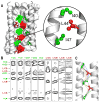Structural dynamics and topology of phosphorylated phospholamban homopentamer reveal its role in the regulation of calcium transport
- PMID: 24207128
- PMCID: PMC3951103
- DOI: 10.1016/j.str.2013.09.008
Structural dynamics and topology of phosphorylated phospholamban homopentamer reveal its role in the regulation of calcium transport
Abstract
Phospholamban (PLN) inhibits the sarco(endo)plasmic reticulum Ca²⁺-ATPase (SERCA), thereby regulating cardiac diastole. In membranes, PLN assembles into homopentamers that in both the phosphorylated and nonphosphorylated states have been proposed to form ion-selective channels. Here, we determined the structure of the phosphorylated pentamer using a combination of solution and solid-state nuclear magnetic resonance methods. We found that the pinwheel architecture of the homopentamer is preserved upon phosphorylation, with each monomer having an L-shaped conformation. The TM domains form a hydrophobic pore approximately 24 Å long and 2 Å in diameter, which is inconsistent with canonical Ca²⁺-selective channels. Phosphorylation, however, enhances the conformational dynamics of the cytoplasmic region of PLN, causing partial unwinding of the amphipathic helix. We propose that PLN oligomers act as storage for active monomers, keeping SERCA function within a physiological window.
Copyright © 2013 Elsevier Ltd. All rights reserved.
Figures






References
-
- Aschar-Sobbi R, Emmett TL, Kargacin GJ, Kargacin ME. Phospholamban phosphorylation increases the passive calcium leak from cardiac sarcoplasmic reticulum. Pflugers Arch. 2012;464:295–305. - PubMed
-
- Becucci L, Foresti ML, Schwan A, Guidelli R. Can proton pumping by SERCA enhance the regulatory role of phospholamban and sarcolipin? Biochim Biophys Acta. 2013;1828:2682–2690. - PubMed
Publication types
MeSH terms
Substances
Associated data
- Actions
Grants and funding
LinkOut - more resources
Full Text Sources
Other Literature Sources
Molecular Biology Databases
Miscellaneous

